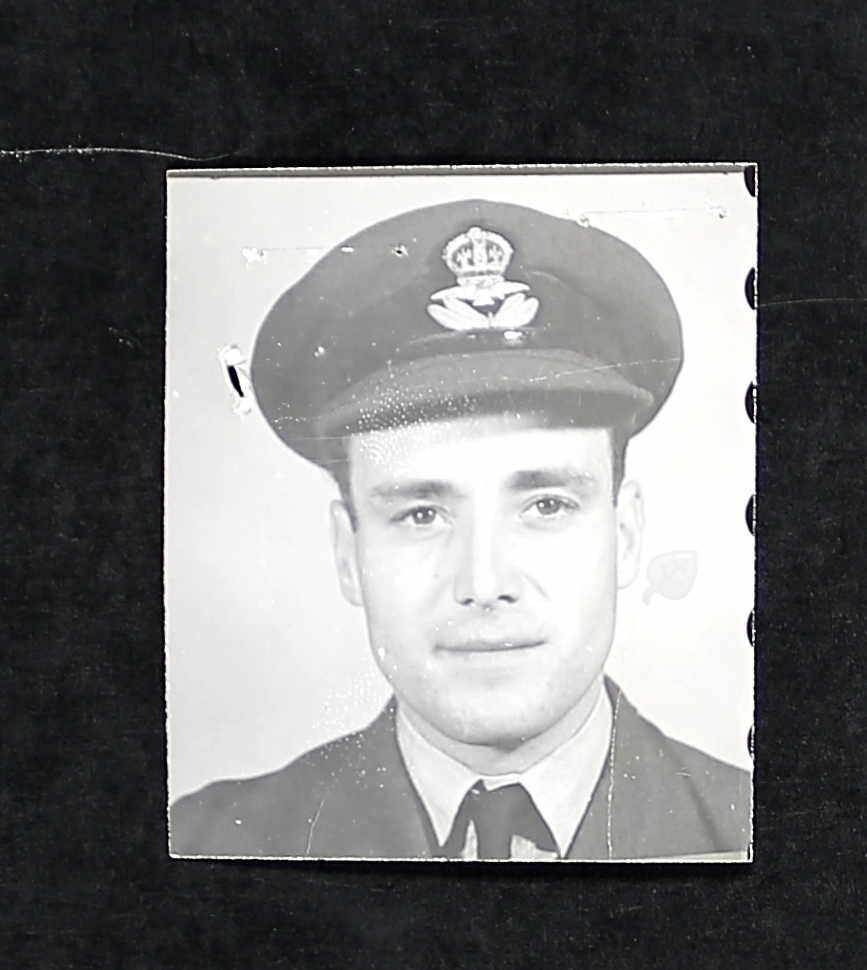
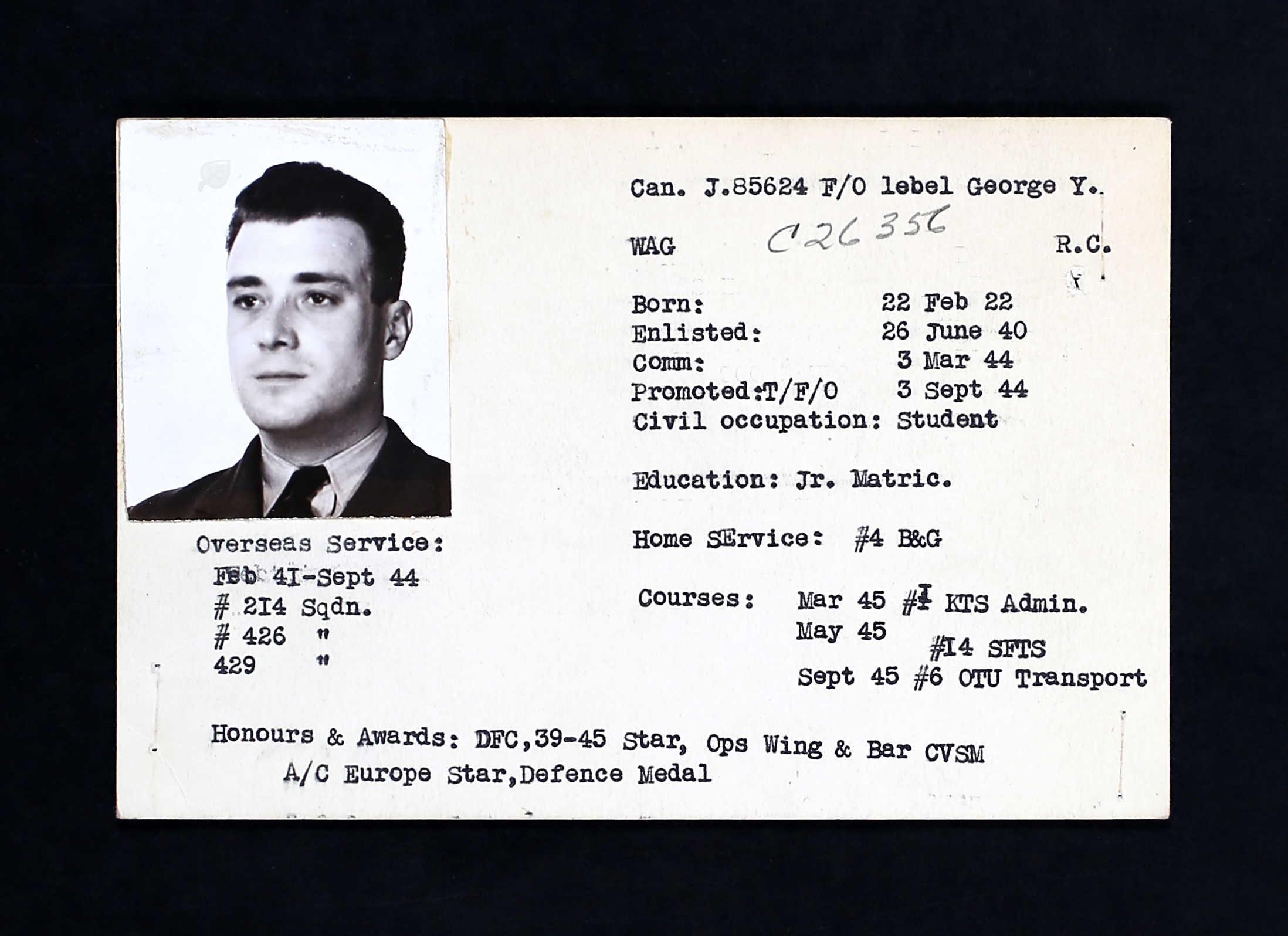

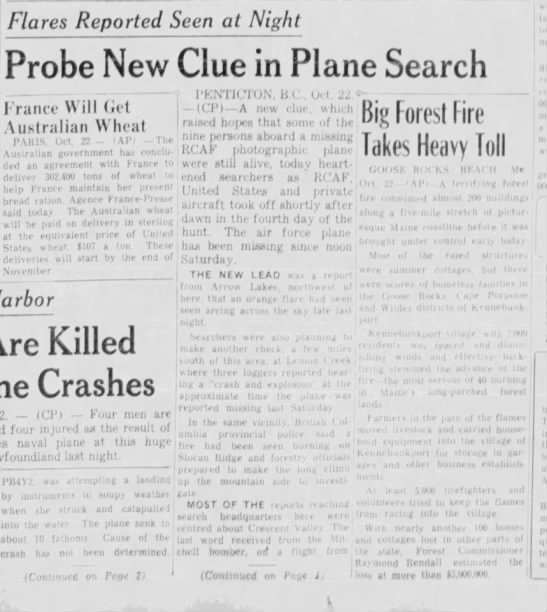
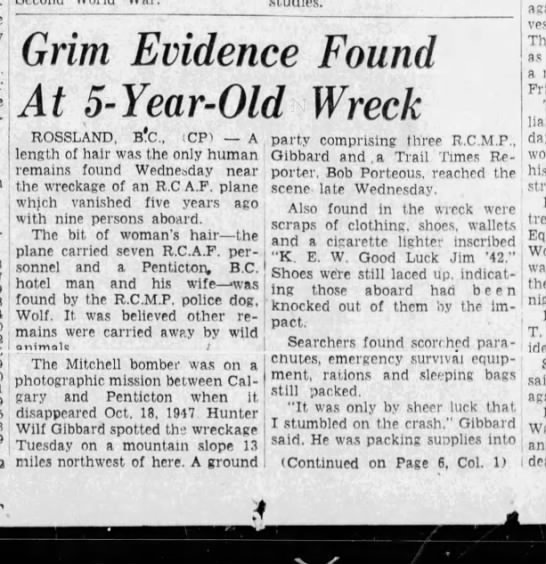
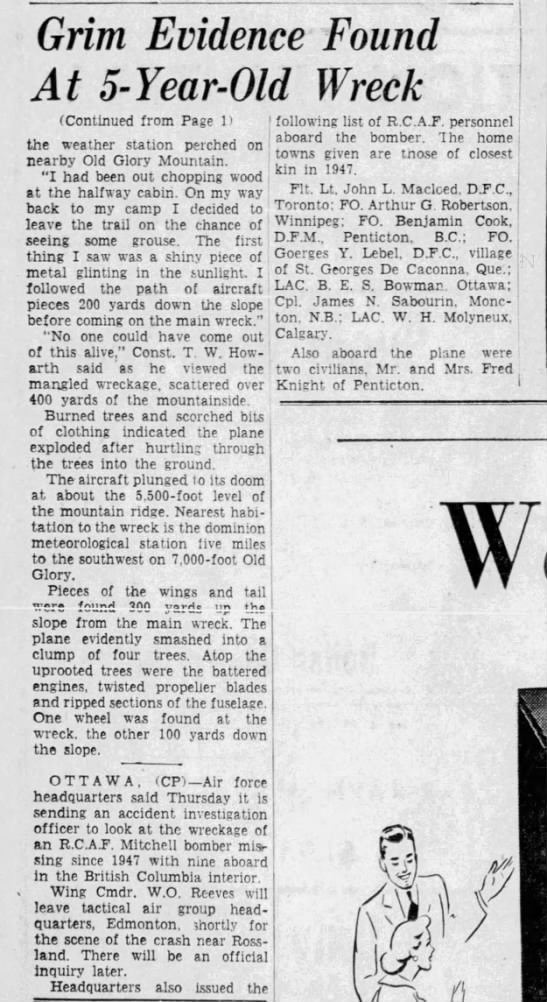
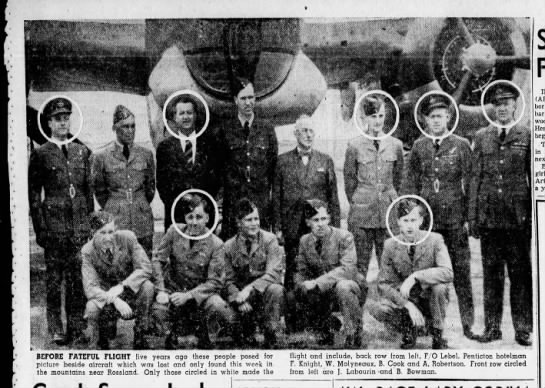
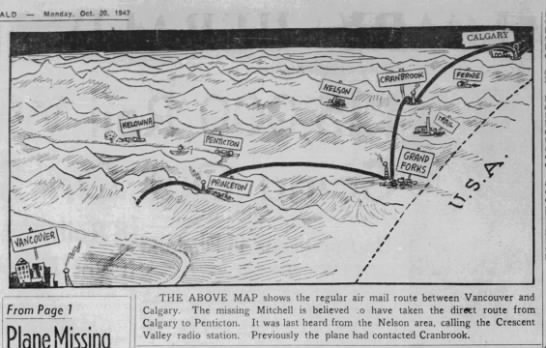
February 20, 1922 - October 18, 1947








George Yvon LeBel, born in Cacouna, Quebec, was the son of Jean-Baptiste LeBel and Cordelia (nee Dumont) LeBel of Riviere-du-Loup, Quebec. He had four brothers: Paul-Etienne, Jean-Pierre, Philippe, and Claude. He had three sisters: Therese, Marie-Paule, and Geraldine. The family was Roman Catholic.
He enjoyed tennis, baseball, hockey, skiing, bicycling, and rowing. He also liked photography. He spoke both English and French. He stood 5’7” tall and weighed 136 pounds. He had brown hair and brown eyes. He smoked 15 cigarettes per day and claimed he never drank alcohol.
Georges enlisted with the RCAF on June 26, 1940, hoping to be a mechanic or a pilot. He had been a student at the time, R. E. Samson Private School, Quebec City. “Good and alert candidate. He practices sports as amateur.”
He was sent to No. 1 ITS, Toronto, July 22, 1940. “Fine type of young man. Should make good gunner material. Although several trainees were failed, the last WO/AG, including LeBel (because they were considered valuable type) were given supplementary examinations which qualified them for a 60% average. The above original marks are used for grading purposes.” Georges was 213rd out of 214 in the class.
From there, he was sent to Calgary and No. 2 Wireless School September 16, 1940. “149th out of 171. 61.1%.”
Then he was sent to No. 4 B&G School, Fingal, Ontario January 18, 1941. Here he received his Air Gunner’s Badge. “71 out of 72 in class. Retained from Course No. 5 mainly due to language difficulty. Tries hard.”
After his training, he was sent to M Depot, Debert, Nova Scotia to be sent overseas.
He had numerous AWLs noted on his General Conduct Sheet. While in Calgary: September 27, 1940: neglecting to obey technical orders, confined to barracks for three days; November 3, 1940: absent without leave 15 hours, 30 minutes. One day’s pay forfeited and seven days’ confined to barracks; November 18, 1940, absent from classes, three days’ confined to barracks; November 30, 1940: absent from classes; five days confined to barracks. In September 1941, he broke out of camp and was absent until apprehended byt the RCAF Service Police; absent for four days, 13 ½ hours. He received a severe reprimand. In October 1942, he was absent from duty for 10 ½ hours and admonished. In March 1943, he was severely reprimanded for entering a station dance hall without a ticket, using bad language at the dance, and not leaving the dance when requested.
Georges was at the station hospital from November 4 to 17, 1942.
Effective July 21, 1944, he was awarded the DFC. He had been aboard Wellington, Stirling, Lancaster, and Halifax aircraft as a wireless operator/air gunner. He had completed two operational tours and one non-operational tour. He was no longer required in the UK for further duty. “While in the UK, trained at No. 2 R. S. and No. 21 O. T. U. on completion of which he joined No. 214 Squadron for operational duty. Completed his first tour of operations and was then assigned to instructional duties. Following 18 months of instructional duties at No. 30 O.T.U., No. 7 A. G. S., and No. 1664 C. U., joined No. 426 Squadron for further operational employment. Was awarded the DFC. On conclusion of his second operational tour, posted for repatriation to Canada. Total flying time is 987 hours, 287 of which are operational.”
With 429 Squadron, he took part in 53 sorties. “An efficient gunner. Speaks French.”
He was repatriated at Rockcliffe, September 18, 1944, placed on the staff of No. 9 B&G School October 28, 1944. It was recommended that he be retained as of January 1, 1945.
By February 1945: “This Officer’s hard work and efficient service to the Air Force is deserving of recognition.”
He attended an officer’s administration course March 8, 1945, then was posted to No. 14 SFTS at the end of March 1945. “This officer’s work was below average throughout the course. he is a French-Canadian with a limited knowledge of English. This handicapped him considerably in his written work. He did make an effort and his work showed improvement toward the end of the course. This officer should be employed on routine work and if possible on a station where his bilingualism will be an asset.”
He was to be released from service on July 30, 1945, but that was cancelled. Georges was sent to No. 1 AC HQ Trenton September 7, 1945 then No. 1 SFTS Camp Borden September er 154, 1945, then to RCAF Stn Lachine a week later. He was then at No. 6 O.T.U. November 22, 1945 taking a Dakota course.
Noted on his general information form, he was retired as of April 16, 1946, but then his services were extended to September 30, 1947. November 1946: “Average officer. Keen and reliable. Sound operator. Good wireless operator and seeks to improve his technical knowledge.”
In March 1947, he was attached to No. 413 (Photography) Squadron.
CREW: • Bliss Eugene Strader Bowman, R195797, LAC -- Aero Engine Mechanic of SON OF JAMES AND OLIVE BOWMAN; HUSBAND OF JOYCE BOWMAN, OF INKERMAN, ONTARIO. • Georges Yvon Lebel 26356, F/O, DFC -- Wireless Operator of SON OF JEAN BAPTISTE LEBEL AND CORDELIA LEBEL, OF RIVIERE-DU-LOUP, PROVINCE OF QUEBEC • Benjamin Cook, 19826, F/O. He earned the DFM. -- Navigator of SON OF WILLIAM JEFFERSON COOK AND EDITH COOK; HUSBAND OF GLADYS MATHER COOK, OF PENTICTON, BRITISH COLUMBIA • William Hugh Molyneux 24798, LAC -- Camera Operator of SON OF WILLIAM HUGH AND EDITH MOLYNEUX • John Leslie MacLeod, 20052, F/L, DFC -- Pilot of SON OF DONALD ALEXANDER AND BLANCHE LOUISA MACLEOD, OF CORNWALL, ONTARIO; HUSBAND OF DOROTHY ALICE MACLEOD • Arthur Gold Robertson, J28663, F/O - Pilot of SON OF JAMES PAUL AND JANET GEORGINA ROBERTSON OF STONEY MOUNTAIN, MANITOBA, AND HUSBAND OF MURIEL IRENE ROBERTSON. • James Noah Sabourin, 22103, Cpl - Airframe Mechanic of SON OF JOSEPH NOAH AND EDITH SABOURIN; HUSBAND OF RUTH C. M. SABOURIN, OF MONCTON, NEW BRUNSWICK
Two civilians: Frederick M. Knight and Beulah Jane (nee Braid) Knight, formerly of Calgary, were also aboard. Mr. Knight was the manager of the Incola Hotel, Penticton, BC, having been in the hotel business for 18 years. They had three children: Cecile, 9, Joan, 5, and Billy, 6. Their children were taken in by a paternal uncle living in Winnipeg.
Mitchell 894 left Calgary, Alberta at 1032 hours, October 18, 1947 on a flight to Penticton, BC, estimated time en route, one hour forty-five minutes. Approximately one hour later, 1132 hours, the aircraft requested Crescent Valley Radio range for Penticton weather, by wireless, but did not give their position. This was given, but not acknowledged by the aircraft. Continuing in a letter by W/C W. R. Gunn, the families were told that the route of the aircraft was over a practically inaccessible area. Air and ground searches were conducted for many weeks, but due to severe winter weather, they were terminated. Several searches continued during better weather without success.
The Calgary Albertan reported on October 20, 1947 that Mrs. Robertson and Mrs Cook arrived on the missing aircraft from Penticton on the Friday. “They understood that the survey work was now completed in the Penticton area and they would be stationed in Calgary for a time. When the plane left Calgary on the return trip, it was expected to pick up equipment and return to Calgary.”
“Five aircraft from Edmonton and two from Vancouver scoured some 30,000 square miles of BC territory…paratroopers flown from Edmonton were standing by in Penticton, ready to jump to the help of the missing plane’s passengers and crew. In addition, 10 planes from the US combed the area of the international border for the missing aircraft, taking off from Seattle. Northwest Air Command revealed that the Mitchell plan was a photographic survey aircraft. It had been carrying out aerial mapping of the Penticton area and was based at the BC town. The craft flew to Calgary Friday and tried to return to its base on the same day. However, icing conditions at 16,000 feet forced it to return to Calgary for the night. It took off from the municipal airport at 1032 am Saturday. It was last heard from one hour and 20 minutes later when it signalled the radio range station at Crescent Valley, BC. The pilot asked for a report on the weather at his point of destination: Penticton. He said he had sufficient gas for a further four hours flying. When the plane left Calgary, it was expected to arrive at Penticton in about two hours but had fuels for a flight of six hours aboard. At the Calgary municipal airport, officials said, to the best of their knowledge, the RCAF transport was to have flown across country along a practically straight line between Calgary and its BC base.” [See articles above.]
In October 1952, the Windsor Star reported that a wreckage was found in the BC interior. The Vancouver Sun had a full report. The reporter from the Trail Times, Bob Porteous, went to the crash site by pack horse and on foot. [See article.]. “A junkyard of death high in the mountains.”
Wilf Gibbard spotted the wreck while out hunting near Rossland, BC. “It was only by sheer luck that I stumbled on the crash. I had been out chopping wood at the halfway cabin. On my way back to my camp, I decided to leave the trail on the chance of seeing some grouse. The first thing I saw was a shiny piece of metal glinting in the sunlight. I followed the path of aircraft pieces 200 yards down the slope before coming on the main wreck.”
“THE AIRCRAFT STRUCK AT 62OO FOOT LEVEL IN A HOURSEHOE ENCLOSURE ON THE EAST SLOPE OFF MOUNT GLORY. AIRCRAFT IMPACT DIRECTION IS WEST TO EAST DOWN SLOPE, BUT DISTANCE DOWN FROM THE TOP (3/4 MILE) AND STEEPNESS PRECLUDES POSSIBLITY OF AIRCRAFT APPROACH FROM WEST. DESCENT IS CONSIDRED TO HAVE BEEN IN OUT OF CONTROL, SPIN, OR SPIRAL CONDITION. ALL COMPONENTS FOUND NEAR BY. ALTHOUGH WATCHES VARY, THERE IS AN INDICATION THAT CRASH OCCURRED A FEW MINUTES AFTER THE RADIO CONTACT WITH THE CRESCENT VALLEY. WEATHER AT TIME WAS CLOUD BELOW MOUNTAIN TOP AT ICING TEMPERATIVE. 894 DID NOT HAVE WING DE ICERS. THERE WAS FIRE ON IMPACT BUT NOT SURVIVORS CAMP FIRE AS STATED IN NEWSPAPERS. ALL RADIO MASTS AND AERIAL WIRES HAVE BEEN RETURNED FOR CHECKING AT 418 SQDN. NONE APPEAR TO BE MISSING. A SMALL QUANTITY OF HUMAN BONES WERE FOUND BUT NO SKULLS. IT COMPRISED THREE HIP SOCKETS, TWO PIECES OF ARM BONE, ANDO NE OF LEG. THREE PIECES FROM A SKULL CROWN, A FEW RIBS AND A PIECE OF JAW CARRYING TWO MOLAR TEETH. THE CORONER AT ROSSLAND BE SUMMONED AND WAS SATISFIED THAT THE VICTIMS WERE THE NINE PERSONS LISTED IN THE AIR FORCE RELEASE. IN MY POSSESSION ARE A NUMBER OF SMALL PERSONAL ARTICLES FROM WHICH SOME OF THE PERSONNEL MAY BE IDENTIFIED. YOUR AUTHORITY TO HAND THESE OVER TO THE B OF I IS REQUESTED.” W/C W. O. REEVES
There is a metal cross at the site of the crash in memorial to those nine who died aboard Mitchell 894.
LINKS: